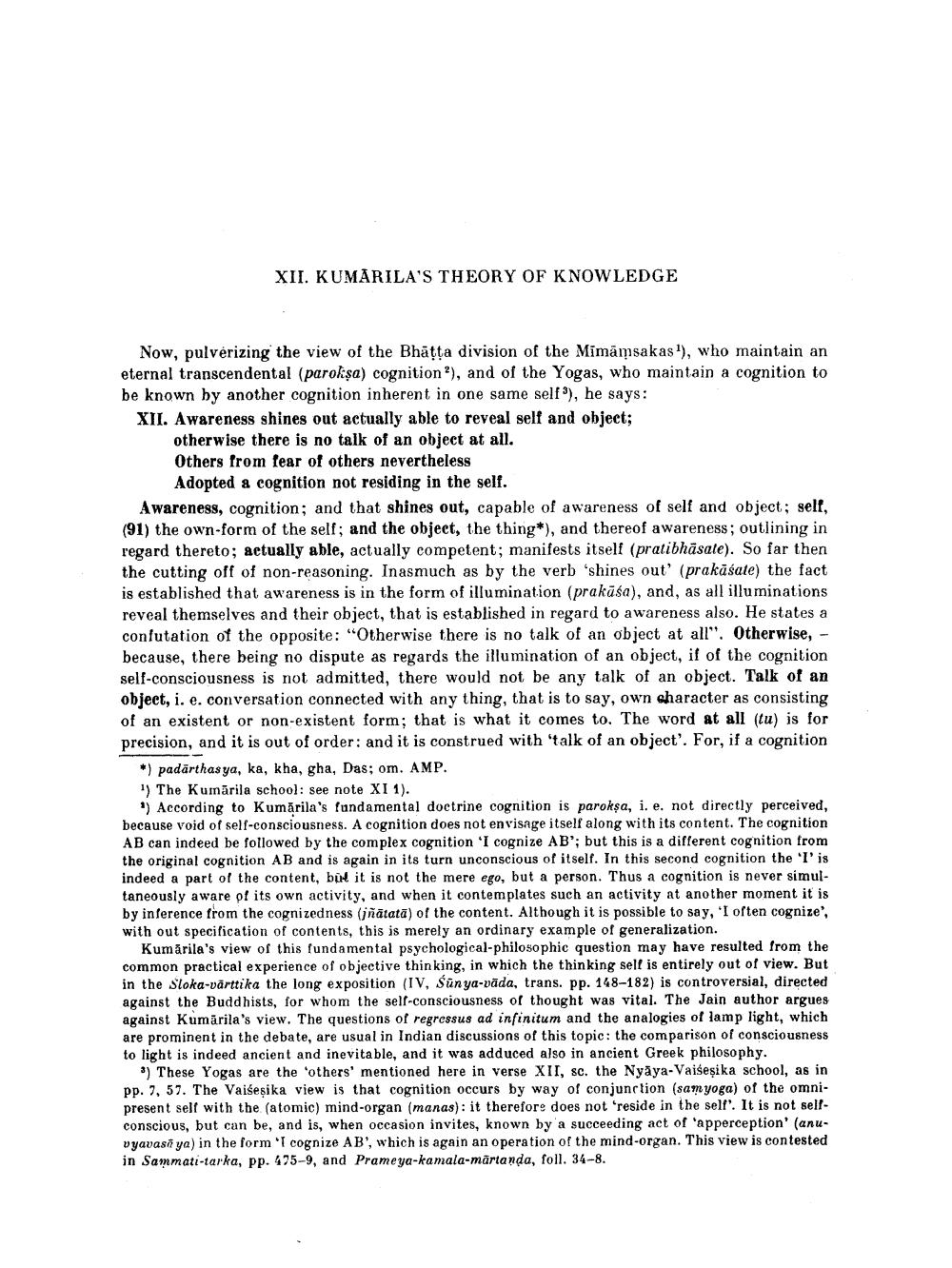________________
XII. KUMARILA'S THEORY OF KNOWLEDGE
Now, pulvérizing the view of the Bhatta division of the Mimāmsakas), who maintain an eternal transcendental (parokşa) cognition), and of the Yogas, who maintain a cognition to be known by another cognition inherent in one same self), he says: XII. Awareness shines out actually able to reveal self and object;
otherwise there is no talk of an object at all. Others from fear of others nevertheless
Adopted a cognition not residing in the self. Awareness, cognition; and that shines out, capable of awareness of self and object; self, (91) the own-form of the self; and the object, the thing*), and thereof awareness; outlining in regard thereto; aetually able, actually competent; manifests itself (pratibhāsale). So far then the cutting off of non-reasoning. Inasmuch as by the verb 'shines out' (prakāśate) the fact is established that awareness is in the form of illumination (prakāśa), and, as all illuminations reveal themselves and their object, that is established in regard to awareness also. He states a confutation of the opposite: "Otherwise there is no talk of an object at all". Otherwise, - because, there being no dispute as regards the illumination of an object, if of the cognition self-consciousness is not admitted, there would not be any talk of an object. Talk of an object, i. e. conversation connected with any thing, that is to say, own character as consisting of an existent or non-existent form; that is what it comes to. The word at all (tu) is for precision, and it is out of order: and it is construed with 'talk of an object'. For, if a cognition
*) padārthas ya, ka, kha, gha, Das; om. AMP. 1) The Kumārila school: see note XI 1).
*) According to Kumărila's fundamental doctrine cognition is parokşa, i. e. not directly perceived, because void of self-consciousness. A cognition does not envisage itself along with its content. The cognition AB can indeed be followed by the complex cognition 'I cognize AB'; but this is a different cognition from the original cognition AB and is again in its turn unconscious of itself. In this second cognition the 'l' is indeed a part of the content, but it is not the mere ego, but a person. Thus a cognition is never simultaneously aware of its own activity, and when it contemplates such an activity at another moment it is by inference from the cognizedness (jñātatā) of the content. Although it is possible to say, 'I often cognize with out specification of contents, this is merely an ordinary example of generalization.
Kumărila's view of this fundamental psychological philosophic question may have resulted from the common practical experience of objective thinking, in which the thinking sell is entirely out of view. But in the Sloka-värttika the long exposition (IV, Sünya-vāda, trans. pp. 148-182) is controversial, directed against the Buddhists, for whom the self-consciousness of thought was vital. The Jain author argues against Kumārila's view. The questions of regressus ad infinitum and the analogies of lamp light, which are prominent in the debate, are usual in Indian discussions of this topic: the comparison of consciousness to light is indeed ancient and inevitable, and it was adduced also in ancient Greek philosophy.
*) These Yogas are the others' mentioned here in verse XII, sc. the Nyāya-Vaiseșika school, as in pp. 7, 57. The Vaišeşika view is that cognition occurs by way of conjunction (sam yoga) of the omnipresent sell with the (atomic) mind-organ (manas): it therefore does not 'reside in the self'. It is not selfconscious, but can be, and is, when occasion invites, known by a succeeding act of 'apperception' (anuvyavasi ya) in the form of cognize AB', which is again an operation of the mind-organ. This view is contested in Sammati-tarka, pp. 475-9, and Prameya-kamala-mārtanda, foll. 34-8.




